Growing of non-perennial crops dominates the sector
About 776 Agriculture, Forestry and Fishing establishments with total employment of 20 and over in business operation nationwide were covered in the 2010 Annual Survey of Philippine and Business and Industry.
Among industry groups, growing of non-perennial crops recorded the highest number of establishments with 243 or 31.3 percent of the total, followed closely by animal production with 220 establishments or 28.4 percent. The count of establishments of other industries are shown below:
- Growing of perennial crops with 135 establishments (17.4%)
- Fishing with 94 establishments (12.1%)
- Aquaculture with 42 establishments (5.4%)
- Support activities to agriculture and post-harvest crop activities with 36 establishments (4.6%)
- Silviculture and forestry activities, and Logging with 6 establishments (0.8%).
Figure 1 shows the percentage distribution of Agriculture, Forestry and Fishing establishments by industry group in 2010.
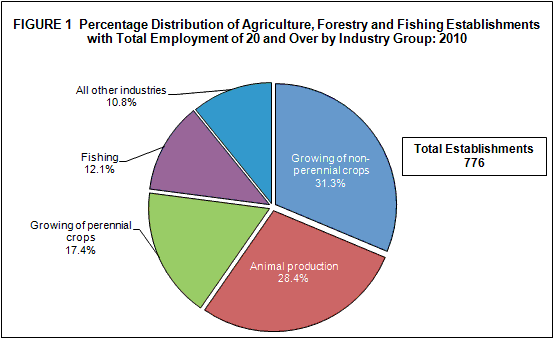
Western Visayas posted the highest number of establishments among regions with 167 or 21.5 percent of the total. This was followed by Davao Region and CALABARZON with 119 establishments (15.3%) and 78 establishments (10.1%), respectively (Table 2).
Growing of perennial crops employs the highest number of workers
Agriculture, Forestry and Fishing establishments employed a total of 128,767 workers in 2010. Of the total workforce, 127,944 workers or 99.4 percent were paid employees and the rest were working owners and unpaid workers.
By industry group, growing of perennial crops employed the largest number of workers with 55,747 or 43.3 percent of the total followed by growing of non-perennial crops providing jobs to 32,860 workers (25.5%). Fishing came in third with 15,482 workers (12.0%) while animal production ranked fourth with 11,434 workers (8.9%).
Figure 2 shows the distribution of employment for Agriculture, Forestry and Fishing establishments by industry group in 2010.
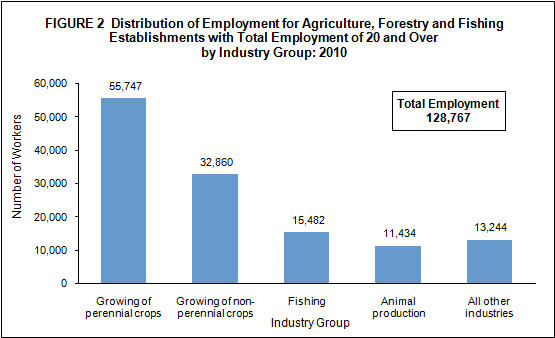
At the regional level, Davao Region was the top employer with 29,371 workers or 22.8 percent of the total. Western Visayas ranked second with 22,413 workers or 17.4 percent. Ilocos Region, on the other hand, registered the least with 215 workers or 0.2 percent (Table 2).
The average number of workers per establishment for the sector was recorded at 166. Industries with highest average number of workers per establishment were as follows:
- Growing of perennial crops, 413 workers per establishment
- Support activities to agriculture and post-harvest crop activities, 244 workers per establishment
- Fishing, 165 workers per establishment
- Silviculture and forestry activities, and Logging, 155 workers per establishment.
On the other hand, animal production posted the lowest average with 52 workers per establishment (Table 1a).
Employees in Support activities to agriculture and post-harvest crop activities are the highest earners
Total compensation paid by Agriculture, Forestry and Fishing establishments in 2010 amounted to PHP16.3 billion, equivalent to an average annual compensation of PHP127,392 per employee.
The highest average annual compensation of PHP205,228 was received by employees in support activities to agriculture and post-harvest crop activities. Employees in growing of perennial crops and fishing, were the second and third highest earners, with average annual compensation of PHP163,175 and PHP132,199, respectively. This was followed by employees in aquaculture with average pay of PHP109,573 annually. On the other hand, employees in growing of non-perennial crops received the lowest average pay with PHP55,252 annually. Figure 3 shows the average annual compensation of employees for Agriculture, Forestry and Fishing establishments by industry group in 2010.
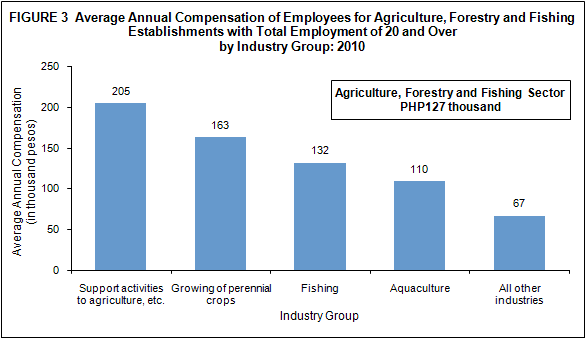
Growing of perennial crops generates highest value of output
Value of output generated in 2010 by Agriculture, Forestry and Fishing establishments reached PHP80.6 billion.
By industry group, growing of perennial crops generated an output value of PHP37.4 billion comprising almost half (46.4%) of the total. The output value of other industries were as follows:
- Animal production with PHP16.1 billion (19.9%)
- Fishing with PHP10.9 billion (13.5%)
- Growing of non-perennial crops with PHP8.3 billion (10.3%)
- Aquaculture with PHP3.9 billion (4.8%)
- Support activities to agriculture and post-harvest crop activities with PHP3.5 billion (4.4%)
- Silviculture and forestry activities, and Logging with PHP481.5 million (0.6%).
Across regions, the combined value of the top three regions comprised PHP49.1 billion or 61.0 percent of the total. Davao Region recorded the highest with PHP19.6 billion or 24.3 percent. SOCCSKSARGEN placed second with PHP17.9 billion or 22.2 percent, followed by Northern Mindanao with PHP11.7 billion or 14.5 percent (Table 2).
Figure 4 shows the percentage distribution of value of output for Agriculture, Forestry and Fishing establishments by industry group in 2010.
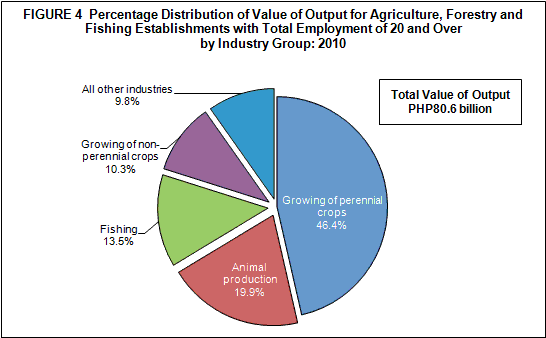
Growing of perennial crops spends the highest
Total cost in business operation, excluding compensation, incurred in 2010 by Agriculture, Forestry and Fishing establishments summed up to PHP62.7 billion.
Among industry groups, growing of perennial crops incurred the highest cost amounting to PHP28.7 billion or 45.8 percent of the total. Animal production ranked second with PHP13.0 billion (20.8%) followed by fishing with PHP9.0 billion (14.4%). The fourth highest spender was growing of non-perennial crops with PHP5.5 billion (8.7%). The remaining PHP6.4 billion (10.2%) of the total cost was spent by other industries (Table 1).
Revenue per Cost stands at 1.31
The ratio of total revenue to total cost in 2010 was 1.31, which implies that for every peso spent PHP1.31 was realized in terms of revenue (Table 1a).
By industry groups, silviculture and forestry activities, and logging registered the highest revenue per peso cost of 1.58. Other top industries in terms of revenue-cost ratio were as follows:
- Growing of non-perennial crops with 1.52 revenue per peso cost
- Support activities to agriculture and post-harvest crop activities with 1.47 revenue per peso cost
- Growing of perennial crops with 1.33 revenue per peso cost.
Value added reaches PHP25.9 billion
Value added generated by Agriculture, Forestry and Fishing establishments was estimated at PHP25.9 billion in 2010 (Table 1).
Among industries, growing of perennial crops contributed the biggest share to value added accounting for PHP12.2 billion or 47.1 percent of the total. Animal production distantly followed with PHP3.9 billion or a share of 15.1 percent. The value added of other industries are listed below.
- Growing of non-perennial crops, 13.9 percent (PHP3.6 billion)
- Fishing, 12.1 percent (PHP3.1 billion).
- Support activities to agriculture and post-harvest crop activities, 7.7 percent (PHP2.0 billion)
- Aquaculture, 3.0 percent (PHP767.8 million)
- Silviculture and forestry activities, and Logging, 1.1 percent (PHP281.8 million).
Labor productivity is highest in Animal production
Labor productivity, defined as the ratio of value added to total employment, was recorded at PHP200,870 per worker.
By industry, animal production registered the highest labor productivity with PHP342,086 per worker, surpassing the national average. Listed below are the other industries that surpassed the national average.
- Silviculture and forestry activities, and Logging with PHP303,615 per worker
- Support activities to agriculture and post-harvest crop activities with PHP227,540 per worker
- Growing of perennial crops with PHP218,571 per worker
- Aquaculture with PHP217,938 per worker
- Fishing with PHP202,444 per worker.
On the other hand, growing of non-perennial crops was the least labor productive and the only industry below the national average with PHP109,095 per worker. Figure 5 shows the labor productivity for Agriculture, Forestry and Fishing establishments by industry group in 2010.
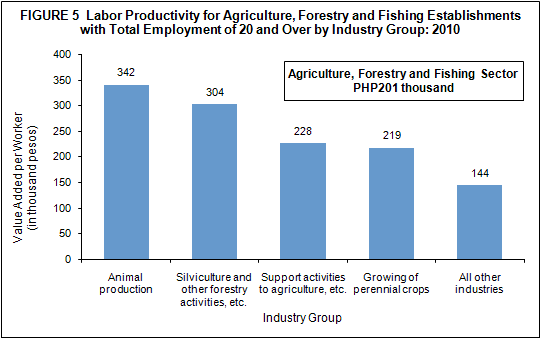
Among regions, Caraga recorded the highest labor productivity ratio with PHP366,319 per worker. This was followed by Central Luzon with PHP347,784 per worker. The least was recorded by Western Visayas with PHP62,304 per worker (Table 2a).
Gross addition to tangible fixed assets totals to PHP4.7 billion
Gross addition to tangible fixed assets, defined as capital expenditures less sale of fixed assets, acquired by Agriculture, Forestry and Fishing establishments was estimated at PHP4.7 billion in 2010 (Table 1).
Among industries, growing of perennial crops acquired about one-third (PHP1.6 billion) of the total gross addition to fixed assets. Other industries with highest gross addition to fixed assets were as follows:
- Support activities to agriculture and post-harvest crop activities with PHP1.3 billion (27.0%)
- Fishing with PHP646.7 million (13.7%)
- Growing of non-perennial crops with PHP589.3 million (12.5%).
By region, NCR accounted for the highest gross addition to tangible fixed assets at PHP1.5 billion or 32.2 percent of the total. SOCCSKSARGEN and Davao Region followed with PHP937.0 million (19.9%) and PHP701.2 million (14.9%), respectively (Table 2).
TECHNICAL NOTES
Introduction
This Special Release presents the preliminary results of the 2010 Annual Survey of Philippine Business and Industry (ASPBI) for the Agriculture, Forestry and Fishing sector for establishments with total employment of 20 and over.
The 2010 ASPBI is one of the designated statistical activities of the National Statistics Office (NSO) with the objective of providing key measures on the levels, structure, trends, and performance of economic activities in the country. As such, the survey generates the most critical and essential statistics required for economic planning and policies. It was conducted in April 2011 with year 2010 as the reference period of data, except for employment which is as of November 15, 2010.
The 2009 Philippine Standard Industrial Classification (PSIC) was adopted for the first time in this survey. This is the latest version of the classification of industries in the country which conforms with the International Standard Industrial Classification Revision 4 prescribed by the United Nations.
Data are presented by 3-digit 2009 PSIC, national and regional levels.
Legal Authority
The conduct of the ASPBI is governed by legislative acts and presidential directives, mainly Commonwealth Act No. 591 which was approved on August 19,1940. Other legislative acts are:
- Presidential Decree No. 418
- Executive Order No. 121
- Executive Order No. 352
- Executive Order No. 5
Scope and Coverage
The 2010 ASPBI covered establishments engaged in 18 economic sectors classified under the 2009 PSIC, namely:
- Agriculture, Forestry and Fishing (A)
- Mining and Quarrying (B)
- Manufacturing (C)
- Electricity, Gas, Steam, and Air Conditioning Supply (D)
- Water Supply; Sewerage, Waste Management and Remediation Activities (E)
- Construction (F)
- Wholesale and Retail Trade; Repair and Maintenance of Motor Vehicles, Motorcycles (G)
- Transportation and Storage (H)
- Accommodation and Food service activities (I)
- Information and Communication (J)
- Financial and Insurance Activities (K)
- Real Estate Activities (L)
- Professional, Scientific and Technical Activities (M)
- Administrative and Support Service Activities (N)
- Education (P)
- Human Health and Social Work Activities (Q)
- Arts, Entertainment and Recreation (R)
- Other Service Activities (S)
The survey was confined to the formal sector of the economy, which consists of the following:
- Corporations and partnership
- Cooperatives and foundations
- Single proprietorship with employment of 10 and over
- Single proprietorships with branches
Unit of Enumeration
Like all other establishments surveys conducted by the NSO, the 2010 ASPBI unit of enumeration is the establishment. The establishment is defined as an economic unit under a single ownership or control which engages in one or predominantly one kind of activity at a single fixed location.
Methodology
Sampling Design
The 2010 ASPBI used stratified systematic sampling with five-digit PSIC serving as first stratification variable and TE as the second stratification variable.
Estimation Procedure




Response Rate
The response rate is 98.1 percent (581 out of 592 establishments). These include receipts of "good" questionnaires, partially accomplished questionnaires, reports of closed, moved out or out of scope establishments.
Concepts and Definitions of Terms
Economic activity is the establishment’s source of income. If the establishment is engaged in several activities, its main economic activity is that which earns the biggest income or revenue.
Total employment is the number of persons who worked in for the establishment as of November 15, 2010.
Paid employees are all persons working in the establishment and receiving pay, as well as those working away from the establishment paid by and under the control of the establishment. Included are all employees on sick leave, paid vacation or holiday. Excluded are consultants, home workers, receiving pure commissions only, and workers on indefinite leave.
Compensation includes salaries and wages, separation/retirement/terminal pay, gratuities, and payments made by the employer in behalf of the employees such as contribution to SSS/GSIS, ECC, PhilHealth, Pag-ibig, etc.
Salaries and wages are payments in cash or in kind to all employees, prior to deductions for employee’s contributions to SSS/GSIS, withholding tax, etc. Included are total basic pay, overtime pay and other benefits.
Revenue includes cash received and receivables for goods/products and by-products sold and services rendered. Valuation is at producer prices (ex-establishment), net of discounts, and allowances, including duties and taxes but excluding subsidies.
Cost refers to all expenses incurred during the year whether paid or payable. Valuation is at purchaser prices including taxes and other charges, net of rebates, returns and allowances. Goods and services received by the establishment from other establishments of the same enterprise are valued as though purchased.
Intermediate cost refers to expenses incurred in the production of goods such as materials and supplies purchased, fuels purchased, electricity purchased, and agricultural/forestry/fishery and industrial services done by others plus beginning inventory of materials, supplies and fuels less ending inventory of materials, supplies and fuels.
Value added is gross output less intermediate cost. Gross output for the agriculture, forestry and fishing sector is value of output plus non-industrial services done for others (except rent income from land). Intermediate input is intermediate cost plus non-industrial services done by others (except rent expense for land) and other costs.
Value of output represents the sum of the receipts from products and by-products sold, agricultural/forestry/fishery services rendered, industrial services, and goods sold in the same condition as purchased less the cost of goods sold; and value of fixed assets produced on own account and change in inventories of finished products and work-in-progress.
Gross addition to tangible fixed assets is equal to capital expenditures less sale of fixed assets, including land.
Change in inventories is equivalent to the value of inventories at the end of the year less the value of inventories at the beginning of the year.
Inventories refer to the stock of goods owned by and under the control of the establishment as of a fixed date, regardless of where the stocks are located. Valuation is at current replacement cost in purchaser prices. Replacement cost is the cost of an item in terms of its present price rather than its original cost.
Subsidies are all special grants in the form of financial assistance or tax exemption or tax privilege given by the government to aid and develop an industry.
